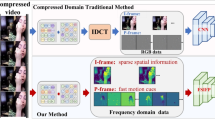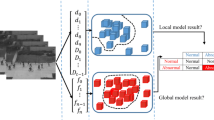Abstract
Since there are differences between students' understanding level, it is easy to produce wrong actions during the process of sports teaching. In order to improve the video detection effect, the video fidelity and compression rate, a remote video detection algorithm for sports wrong actions under wireless network is proposed. By extracting key frames in video clips, a real-time video transmission model is established based on wireless network, which transmits key frame extraction results real time with the support of real-time transmission protocol and forward error correction mechanism. The deterministic constrained nonlinear optimization method is used to estimate joint and overall motion parameters. Based on each parameter, the aggregated channel feature method is used to identify the target in the video sequence, and the support vector machine is used as a classifier of sports actions to recognize wrong actions. Then, the multi-scale space of moving images is constructed, the multi-layer box filter is used to simulate Gaussian convolution, and the simulation results are corresponded to the target areas in the remote video of sports wrong actions, thereby realizing the remote video detection of sports wrong actions. The experimental results show that the fidelity rate of the proposed algorithm is always above 90.3%, the compression rate is more than 80%, and only one key point is omitted. This proves that the video fidelity rate and compression rate of this method are high, and the detected key points are the same as the actual key points, which verifies the effectiveness of the proposed algorithm.








Similar content being viewed by others
Data availability
All authors declared that the manuscript has no associated data.
References
Gråstén, A., & Yli-Piipari, S. (2019). The patterns of moderate to vigorous physical activity and physical education enjoyment through a 2-year school-based program. Journal of School Health, 89(2), 88–98.
Guzman-Pando, A., Chacon-Murguia, M. I., & Chacon-Diaz, L. B. (2020). Human-like evaluation method for object motion detection algorithms. IET Computer Vision, 14(8), 674–682.
Park, J. S., Park, C., & Manocha, D. (2019). I-Planner: Intention-aware motion planning using learning-based human motion prediction. The International Journal of Robotics Research, 38(1), 23–39.
Jiménez Bascones, J. L., Graña, M., & Lopez-Guede, J. M. (2019). Robust labeling of human motion markers in the presence of occlusions. Neurocomputing, 353(11), 96–105.
Yang, T., Zhu, X. A., & Zhang, F. (2021). Fake face video detection method based on improved triplet loss. Application Research of Computers, 38(12), 3771–3775.
Li, Y. D., & Xu, X. P. (2019). Video saliency detection method based on spatiotemporal features of superpixels. Acta Optica Sinica, 39(01), 315–322.
Yao, P. (2022). Key frame extraction method of music and dance video based on multicore learning feature fusion. Scientific Programming, 2022(7), 1–8.
Tran, T. H., & Chen, L. (2021). Wall shear-stress extraction by an optical flow algorithm with a sub-grid formulation. Acta Mechanica Sinica, 37(1), 65–79.
Liu, S., Li, Y., & Fu, W. (2022). Human-centered attention-aware networks for action recognition. International Journal of Intelligent Systems. https://doi.org/10.1002/int.23029
Panda, S., & Nanda, P. K. (2021). Kernel density estimation and correntropy based background modeling and camera model parameter estimation for underwater video object detection. Soft Computing, 25(15), 10477–10496.
González, B. J., & Negrína, E. R. (2019). On operators with complex Gaussian kernels over Lp spaces. Filomat, 33(9), 2861–2866.
Shuai, L., Shichen, H., Weina, F., & Jerry, C. W. L. (2022). A descriptive human visual cognitive strategy using graph neural network for facial expression recognition. International Journal of Machine Learning and Cybernetics. https://doi.org/10.1007/s13042-022-01681-w
Raufmehr, F., Salehi, M. R., & Abiri, E. (2021). A frame-level MLP-based bit-rate controller for real-time video transmission using VVC standard. Journal of Real-Time Image Processing, 18(3), 751–763.
Liu, Y., Tang, S., Wu, H. T., & Zhang, X. (2019). RTPT: A framework for real-time privacy-preserving truth discovery on crowdsensed data streams. Computer Networks, 148(15), 349–360.
Liu, S., Xu, X., Zhang, Y., Muhammad, K., & Fu, W. (2022). A reliable sample selection strategy for weakly-supervised visual tracking. IEEE Transactions on Reliability. https://doi.org/10.1109/TR.2022.3162346
Abdellaoui, M., & Douik, A. (2020). Human action recognition in video sequences using deep belief networks. Traitement du Signal, 37(1), 37–44.
Ananth, C., & Brabin, D. (2020). Enhancing segmentation approaches from Gaussian mixture model and expected maximization to super pixel division algorithm. Sylwan, 164(4), 15–32.
Rajasekar, V., Premalatha, J., & Sathya, K. (2021). Cancelable Iris template for secure authentication based on random projection and double random phase encoding. Peer-to-Peer Networking and Applications, 14(4), 1–16.
Borges, F., Pinto, A., Ribeiro, D., Barbosa, T., & Ferreira, D. (2020). An unsupervised method based on support vector machines and higher-order statistics for mechanical faults detection. IEEE Latin America Transactions, 18(6), 1093–1101.
Liao, R., & Tao, B. H. (2021). Wireless video monitoring design based on HI3518EV200. Electronic Design Engineering, 29(15), 5.
Vatavu, A., Rahm, M., Govindachar, S., Krehl, G., & Maile, M. (2021). From particles to self-localizing tracklets: A multilayer particle filter-based estimation for dynamic grid maps. IEEE Intelligent Transportation Systems Magazine, 12(4), 149–168.
Tu, Y., Lin, Y., & Zha, H. (2022). Large-scale real-world radio signal recognition with deep learning. Chinese Journal of Aeronautics, 35(9), 35–48.
Shuai, L., Peng, G., Yating, L., Weina, F., & Weiping, D. (2023). Multi-modal fusion network with complementarity and importance for emotion recognition. Information Sciences, 619, 679–694.
Author information
Authors and Affiliations
Contributions
All authors contributed to the study conception and design. Material preparation, data collection and analysis were performed by TY. The first draft of the manuscript was written by HL and all authors commented on previous versions of the manuscript. All authors read and approved the final manuscript.
Corresponding author
Additional information
Publisher's Note
Springer Nature remains neutral with regard to jurisdictional claims in published maps and institutional affiliations.
Rights and permissions
Springer Nature or its licensor (e.g. a society or other partner) holds exclusive rights to this article under a publishing agreement with the author(s) or other rightsholder(s); author self-archiving of the accepted manuscript version of this article is solely governed by the terms of such publishing agreement and applicable law.
About this article
Cite this article
Liu, H., Yang, T. Remote video detection algorithm of sports wrong actions under wireless network. Wireless Netw 29, 3017–3026 (2023). https://doi.org/10.1007/s11276-022-03227-y
Published:
Issue Date:
DOI: https://doi.org/10.1007/s11276-022-03227-y




